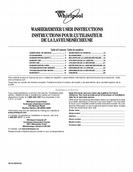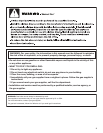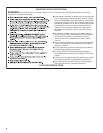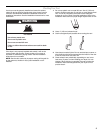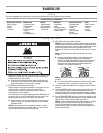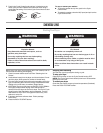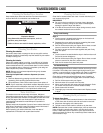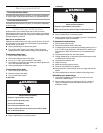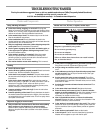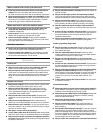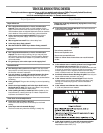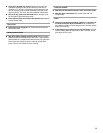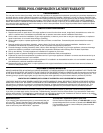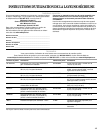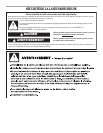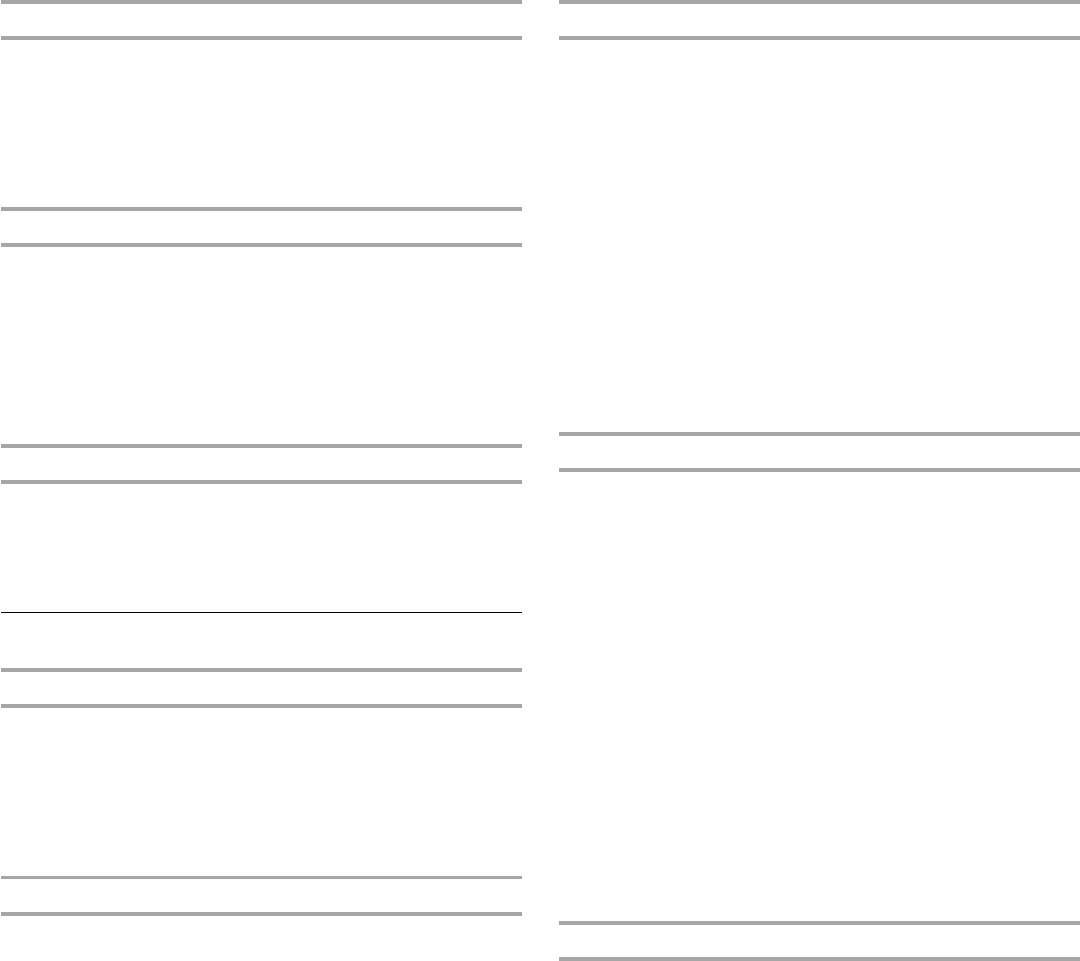
11
Washer continues to fill or drain; cycle seems stuck
■ Is the top of drain hose lower than the control knobs on
washer? The top of the drain hose must be at least
39" (990 mm) above the floor. See the Installation Instructions.
■ Does the drain hose fit too tightly in the standpipe, or is it
taped to the standpipe? The drain hose should be loose yet
fit securely. Do not seal the drain hose with tape. The hose
needs an air gap. See the Installation Instructions.
Washer won’t drain or spin; water remains in washer
■ Is the drain hose clogged, or the end of the drain hose
more than 96" (2440 mm) above the floor? See the
Installation Instructions.
■ Is the lid open? The lid must be closed during operation.
Washer will not agitate or spin with the lid open.
■ Is there excessive sudsing? Always measure detergent.
Follow manufacturer’s directions. If you have very soft water,
you might need to use less detergent.
Wash/Rinse temperature
■ Are the hot and cold water inlet hoses reversed? See
“Connect Inlet Hoses” in the Installation Instructions.
■ Are you washing many loads? As your frequency of loads
washed increases, the water temperature may decrease for
hot and warm temperatures. This is normal.
Clothing Care
Load too wet
■ Did you use the right cycle for the load being washed?
Select a cycle with a higher spin speed (if available).
■ Did you wash an extra-large load? A large unbalanced load
could result in a reduced spin speed and wet clothes at the
end of the cycle. Evenly distribute the load and make sure the
height of the load does not exceed the top row of basket
holes.
Residue or lint on load
■ Did you sort properly? Sort lint givers (towels, chenille) from
lint takers (corduroy, synthetics). Also sort by color.
■ Did you overload the washer? The wash load must be
balanced and not overloaded. Clothes should move freely.
Lint or powdered detergent can be trapped in the load if
overloaded. Wash smaller loads.
■ Did you select the correct water level? The water level
should be correct for the load size. The load should be under
water.
■ Did you use enough detergent? Follow manufacturer’s
directions. Use enough detergent to hold the lint in the water.
■ Did you line dry your clothing? If so, you can expect some
lint on the clothing. The air movement and tumbling of a dryer
removes lint from the load.
■ Was paper or tissue left in the pockets?
■ Is your water colder than 60°F (15.6°C)? Wash water colder
than 60°F (15.6°C) may not completely dissolve the detergent.
■ Did you use the proper cycle time and agitation speed for
the load? Reducing wash time (duration) and agitation speed
are ways to reduce lint.
Load is wrinkled, twisted, or tangled
■ Did you unload the washer promptly? Unload the washer as
soon as it stops.
■ Did you use the right cycle for the load being washed?
Use cycles with shorter wash times and low wash and spin
speeds (if available) to reduce wrinkling, tangling, and twisting.
■ Did you overload the washer? The wash load must be
balanced and not overloaded. Loads should move freely
during washing to reduce wrinkling, tangling, and twisting.
■ Was the wash water warm enough to relax wrinkles? If
safe for the load, use warm or hot wash water. Use cold rinse
water.
■ Are the hot and cold water hoses reversed? Check that the
hot and cold water hoses are connected to the right faucets. A
hot rinse followed by spin will cause wrinkling. See the
Installation Instructions.
■ Did you wrap items around the agitator? Drop items loosely
into the washer. Do not wrap items around the agitator.
Stains, gray whites, dingy colors
■ Did you properly sort the load? Transfer of dye can occur
when mixing whites and colors in a load. Sort dark clothes
from whites and lights.
■ Was the wash temperature too low? Use hot or warm
washes if safe for the load. Make sure your hot water system
is adequate to provide a hot water wash.
■ Did you use enough detergent, or do you have hard
water? Use more detergent for washing heavy soils in cold or
hard water.
■ Are the hot and cold water hoses reversed? Check that the
hot and cold water hoses are connected to the right faucets.
See the Installation Instructions.
■ Did you follow the manufacturer’s directions when adding
detergent and fabric softener? Measure detergent and
fabric softener. Use enough detergent to remove soil and hold
it in suspension. Dilute fabric softener and add to the rinse
portion of a cycle only. Do not drip fabric softener onto
clothes.
■ Is there above average iron (rust) in water? You may need
to install an iron filter.
Garments damaged
■ Were sharp items removed from pockets before washing?
Empty pockets, zip zippers, snap, or hook fasteners before
washing to avoid snagging and tearing of load.
■ Were strings and sashes tied to avoid tangling? Straps and
strings can easily become entangled in the load, causing
strain on seams and tearing.
■ Were items damaged before washing? Mend rips and
broken threads in seams before washing.
■ Did you overload the washer? The wash load must be
balanced and not overloaded. Loads should move freely
during washing.
■ Did you add chlorine bleach properly? Do not pour chlorine
bleach directly onto load. Wipe up bleach spills. Undiluted
bleach will damage fabrics. Do not place load items on top of
the bleach dispenser when loading and unloading the washer
(on some models). Do not use more than the manufacturer's
recommended amount for a full load.
■ Did you follow the manufacturer’s care label instructions?













